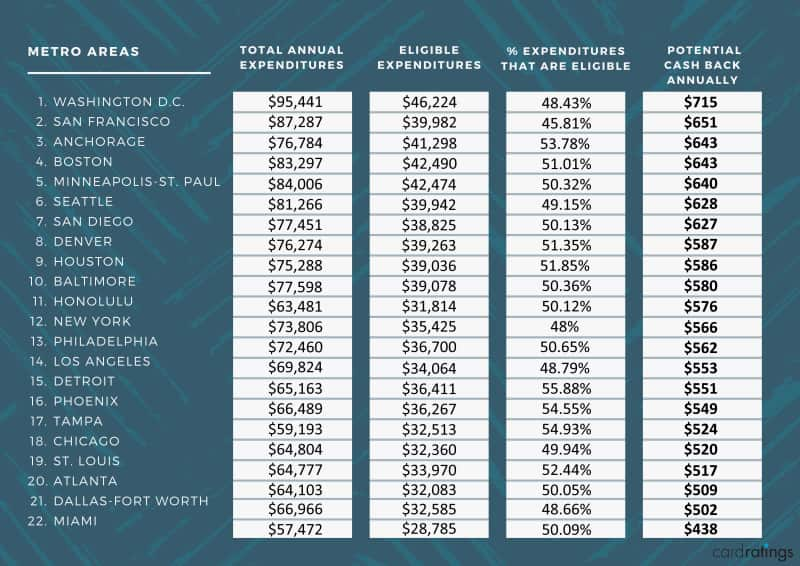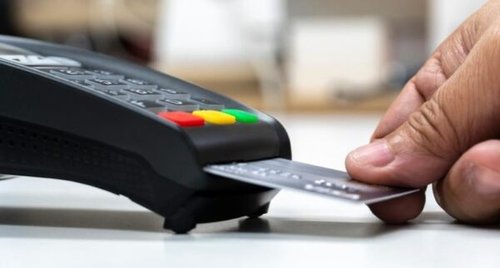As the U.S. economy bounces back from the pandemic, something else has come roaring back – inflation. As higher prices cause you to spend more, it’s more important than ever to get your money’s worth from cash-back credit cards.
This can be a big help to your budget. A new study by CardRatings.com found that based on normal expenditures, residents of America’s biggest cities could be getting hundreds of dollars a year in cash back from their credit cards.
As a reminder to people to take advantage of these deals, CardRatings.com has ranked 22 cities based on where the potential for cash back rewards is greatest.
The nice thing is, there are no losers in this ranking. The potential annual cash back in these cities ranged from a low of $438 to a high of $715. No matter where you live, those are dollars well worth having. Furthermore, while the specific study data is only available for these cities, that isn’t to say that cash-back earnings aren’t a nice addition to your wallet no matter where you live.
Determining who gets the most from their cash back credit cards
How did CardRatings.com figure out the potential cash back in each city? This was based on two things:
- The average amount spent on various types of purchases in each city, according to the Bureau of Labor Statistics (BLS)
- The average reward amounts available on those types of purchases, based on a CardRatings analysis of its best cash-back cards in various spending categories
This approach allowed CardRatings.com to figure out the potential for cash back rewards in the 22 different cities for which the BLS provides spending data. The analysis serves as a good reminder of two things that can determine how much cash back you earn each year: What you spend money on and how much cash-back your credit card offers.
Based on average rewards from the CardRatings cash-back cards included on category specific pages, the reward levels used for various expenditure types were as follows:
- Groceries: 3%
- Dining out: 3%
- Gasoline: 2%
- All other eligible categories: 1%
Where does cash back pay the most
The CardRatings.com analysis found that residents of Washington, D.C. could potentially earn the most from cash-back credit cards.
What makes D.C. the cash back king? It’s simple. On average, its residents spend the most of any of the 22 metropolitan areas whose spending data are compiled by the BLS.
Residents of Washington, D.C. spend an average of $95,441 per year. That’s well above the average of $72,874 for all 22 of the cities.
Nearly half of those expenditures (48.4%) would be eligible for typical cash-back programs. Applying the average cash back rates for various categories of spending, CardRatings.com calculated that the average Washington, DC resident could be earning $715 in cash-back rewards.
Top 10 cities for best cash-back potential
Here are the top 10 cities ranked for potential cash back rewards:
1. Washington, D.C. See the section above for details on why D.C. is the cash-back king.
2. San Francisco. At $87,287, San Francisco’s average annual consumer spending is second only to the nation’s capital. Not surprisingly, then, that its residents have the second-highest potential for cash-back rewards, at $651.
3. (tie) Anchorage. Average annual consumer expenditures are only a little above average in Anchorage, at $76,784. However, an unusually high percentage of this total is spent in reward-eligible categories, especially in the higher reward categories of food and gas. This resulted in $643 in potential cash-back rewards.
3. (tie) Boston. With $83,297 in annual expenditures, residents of Boston shell out noticeably more every year than their counterparts in Anchorage. Significantly though, a lower percentage of those expenditures are in reward-eligible categories. That trade off between total spending and cash-back eligibility resulted in a tie between the two cities at $643 in potential cash-back rewards.
5. Minneapolis. On average, people in Minneapolis spend the third most out of all 22 metro areas measured. However, a slightly-below average percentage of eligible expenditures pushed them a little farther down the list in potential rewards, at $640.
6. Seattle. Average annual consumer expenditures of $81,266 are more than in most cities. This helps put Seattle in the top 10 with an average of $628 in potential cash back rewards.
7. San Diego. Consumer spending in San Diego is above average, at $77,451. When analyzed by category, this translates to potential annual cash back rewards of $627.
8. Denver. Both annual spending and the percentage of spending that would be eligible for cash-back rewards are a little above average in Denver. Combined, this translates to potential annual rewards of $587.
9. Houston. Average consumer expenditures in Houston are just a little below those in Denver, which helps explain why potential cash back rewards in Houston fell a dollar below Denver’s, at $586.
10. Baltimore. This is a reminder that earning cash-back rewards depends not just on how much you spend, but what you spend it on. Average annual consumer spending in Baltimore is higher than in four of the cities ahead of it on this list. However, a below-average percentage of that spending is in reward-eligible categories, resulting in an average potential reward of $580.
Getting the most out of your cash-back card
Regardless of where you live, there are steps you can take to make the most of cash-back credit card offers:
- Understand your spending habits. How you use your rewards card matters. Cards often offer different reward percentages for different categories of spending, such as food, gas, etc. Figuring out how to get the greatest rewards starts with knowing which categories are likely to represent most of your spending.
- Recognize the power of cash. Credit card rewards come in different forms. You may accumulate air miles, credit at different hotel chains or points towards purchases at specific retailers. But why limit yourself? Cash-back rewards are certainly the most flexible because you can use them however you want.
- Compare how offers would benefit you. When you compare credit card offers, you’ll notice that not just the amount of cash back but the conditions for earning those rewards vary. So you have to think about the different percentages, spending categories and other conditions. Additionally, make sure you take an annual fee into account. If there’s an annual fee, but you’ll more than offset it with your rewards, you’re in good shape.
- Watch out for low ceilings. Some cards put a limit on how much spending is eligible for rewards. These reward ceilings can really cut back the rewards you earn if you are a big spender. When choosing a card, be aware of any reward ceilings, and whether they would be likely to affect you.
- Make your card pay you – not the other way around. Cash-back rewards are great, but it’s not a one-way deal. You may get cash back on money you spend with the credit card, but you will pay interest if you carry a balance on that card. Since rewards are typically 1 to 3% of your purchases while credit card rates are more like 16% of any balance outstanding (at least!), it wouldn’t take long for the interest you pay to more than wipe out the rewards you earn, so get in the habit of paying your balance off in full every month.
- Don’t neglect your rewards. Not all rewards programs work automatically. Some require you to periodically register for new rewards or categories. Most require you to redeem your rewards in order to receive credit for them, and some of those rewards may expire if you don’t. Know what is required for you to earn rewards, and make a habit of cashing them in regularly, at least once a year.
This study of how average spending habits in various major cities can earn big rewards is intended as a reminder that you don’t have to change your spending habits to benefit from a cash-back credit card. In fact, spending more than you normally would is a bad idea, especially if it causes you to carry a balance on your card.
Instead, pick a cash back card based on how it fits with your existing spending habits. That way, you can earn rewards on things you would be buying anyway. That’s a win no matter where you live.
Complete List: Where all the cities rank by potential cash-back rewards



